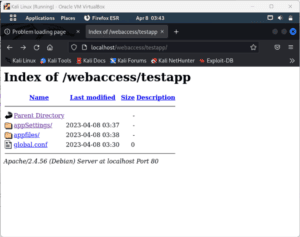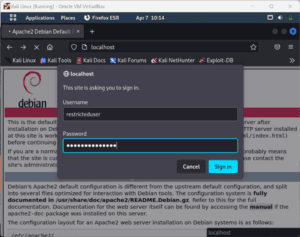1. Overview
In this tutorial, we’ll look at how to prevent the Apache2 web server from serving particular directories. The Apache2 web server provides various functions that we can configure to restrict or allow access to specific directories. We’ll look at rules that can grant or prohibit access to folders and learn how to protect a folder using a password.
2. Apache2 in a Nutshell
Apache2 web server is a free and open-source web server. It’s cross-platform and among the commonly used web servers in Linux. In some Debian systems, Apache2 isn’t present by default.
Let’s run apt-get to install the web server:
$ sudo apt-get update
$ sudo apt-get install apache2 apache2-utils
If the installation is successful, the web server should be active:
$ sudo systemctl status apache2
● apache2.service - The Apache HTTP Server
Loaded: loaded (/lib/systemd/system/apache2.service; enabled; vendor preset: enabled)
Active: active (running) since Mon 2023-04-03 08:17:10 EAT; 4min 47s ago
Docs: https://httpd.apache.org/docs/2.4/
Main PID: 3759 (apache2)
Tasks: 55 (limit: 1636)
Memory: 7.0M
CPU: 117ms
The apache2-utils package contains a configuration file called .htpasswd that we can configure to store passwords, which the server uses to restrict content. To configure Apache2, we modify the following files:
- apache2.conf, the main Apache2 configuration file containing the global settings. In older systems, we have httpd.conf instead of apache2.conf file and it serves the same purpose.
- sites-available/ directory has the configuration files for Apache2 virtual host. The virtual hosts allow us to configure Apache2 for multiple sites with separate settings.
- Other vital directories are sites-enable,parts-conf, and conf-available. The remaining files are magic (used to determine the MIME type based on the first few bytes) and environment variables.
After saving the changes we’ve made to the main configuration file, we can quickly check if the setting is correct by running:
$ sudo apachectl configtest
AH00526: Syntax error on line 179 of /etc/apache2/apache2.conf:
Either all Options must start with + or -, or no Option may.
Action 'configtest' failed.
The Apache error log may have more information.
This command will quickly point to any wrong configuration we might be having in the file. Any changes to the main configuration files are only effective after Apache2 is started or restarted.
3. Creating Allow and Deny Rules
Apache2’s ruled-based access control allows us to specify the specific resources that various users can access. We can create rules that allow or deny access to directories from specific URLs or IP addresses. We can also create rules that control the kind of resources that users can access over the network.
Let’s look at some rules we can make to limit directory access.
3.1. Limit IP From Accessing a Directory
If we want to restrict a particular IP or range of IP, we can define it in the following ways.
First, we can specify the IP address to allow or block, e.g., Allow 192.168.0.1. Secondly, we can specify the beginning octets of the IP address, e.g., Allow 192.168 or Deny 200.10.0. When we create Allow directives, we should ensure that the correct IP can only access the resources it needs.
Let’s configure this rule in apache2.conf to restrict access to the directory from particular IP:
<Directory /var/www/html/webaccess/register_info>
Order allow,deny
Allow from 127.0.0.1
</Directory>
3.2. Restrict Urls
We can configure Apache2 to allow or deny access based on the hostname of where the request came from. For this to work, Apache2 performs a reverse DNS lookup of the hostname that has made the request. Only the allowed hostname can access the resource, e.g., Allow hostname.example.com:
<Directory /var/www/html>
Order Deny,Allow
Deny from all
Allow from hostname.example.com
</Directory>
We can also create rules that deny access to a particular directory. Once the rule is applied, the sub-directories inherit the same rules:
<Directory /var/www>
Options Indexes FollowSymLinks
AllowOverride None
Require all granted
</Directory>
Additionally, we can also create access rules based on environment variables in the HTTP session. This makes it possible for us to allow or deny access to a resource based on a variable such as a user agent (browser) or referrer.
3.3. Other Ways to Restrict Directories
When we create the rules, we must specify them explicitly. This ensures the directive set will only match the specific directory provided in the path. Even though rules are inherited by the child directories, we can enable subdirectories anywhere in the tree by writing directives that oppose the parent rules:
<Directory /var/www/html/webaccess>
Options FollowSymLinks Indexes
AllowOverride None
Order deny,allow
deny from all
</Directory>
<Directory /var/www/html/webaccess/testapp>
Order allow,deny
allow from all
</Directory>
We can’t access the webaccess/ directory through the browser:

On the other hand, we’re able to access the child directory testapp/:

If we don’t want this setup, we can use the
<LocationMatch "^/da">
Order deny,allow
deny from all
</LocationMatch>
This directive would apply to any directory whose name begins with “da” in the directory tree.
4. Password-protect a Directory
In this section, we’ll look at how we can only server directories to authorized users. Anyone from the authorized users cannot access the password-protected directory unless they have a password. We can configure the Apache2 web server to restrict access to any directory.
First, let’s create a password file that Apache2 will use to authenticate users. We create a hidden file called .htpasswd and place it inside the /etc/apache2/ directory:
$ sudo htpasswd -c /etc/apache2/.htpasswd restricteduser
New password:
Re-type new password:
Adding password for user restricteduser
$ cat /etc/apache2/.htpasswd
restricteduser:$apr1$ygHh/XYr$Qjz5tgHEQ6L/f5rpq0ct71
If it’s the first time creating this file, we must use the -c flag to add a user. On running the command, it prompts us to enter and confirm a password for the user.
Next, let’s configure Apache2 to read this file before serving our restricted content. When we’re setting up password protection, we can either use the virtual host or set up a .htaccess file.
4.1. Setting Password Protection Using Virtual Host
If we decide to use a virtual host, we add the following block to the configurations file:
$ sudo vi /etc/apache2/sites-enabled/000-default.conf
<VirtualHost *:80>
<Directory "/var/www/html">
AuthType Basic
AuthName "Restricted Content"
AuthUserFile /etc/apache2/.htpasswd
Require valid-user
</Directory>
</VirtualHost>
Let’s save and restart the web server:
$ sudo service apache2 restart
We’ve added our password protection to the virtual host file, and adding it here improves performance.
4.2. Setting Access Control Using .htaccess
If we’re using .htacces instead, let’s edit the apache2.conf:
$ sudo vi /etc/apache2/apache2.conf
Following, let’s locate the <Directory /var/www> block where we add the following lines:
<Directory /var/www/html>
Options Indexes FollowSymLinks
AllowOverride All
Require all granted
</Directory>
To enable .htaccess file processing, we change the AllowOverride from “none” to “All”. The AuthUserFile directive tells Apache2 where to find the password file we created. Lastly, the valid-user ensures that only the verified users can be served this resource.
Finally, we add the .htaccess file to the directory we want to restrict. For example, to restrict the entire document root we create the .htaccess file in the html/ directory:
$ sudo vi /var/www/html/.htaccess
AuthType Basic
AuthName "Restricted Content"
AuthUserFile /etc/apache2/.htpasswd
Require valid-user
We save and close the file and then restart the server for the changes to take effect:
$ sudo service apache2 restart
If we access the server through the browser, it should prompt for a password:

5. Conclusion
In this article, we’ve looked at how to prevent Apache2 from serving particular directories. We’ve discussed how we use directives to take a directory offline, restrict IP addresses from accessing specific directories and restrict URLs. We’ve also looked at how to password-protect our directories and only allow authorized users to access those directories.